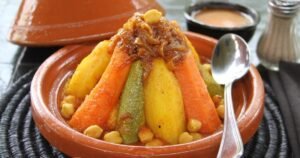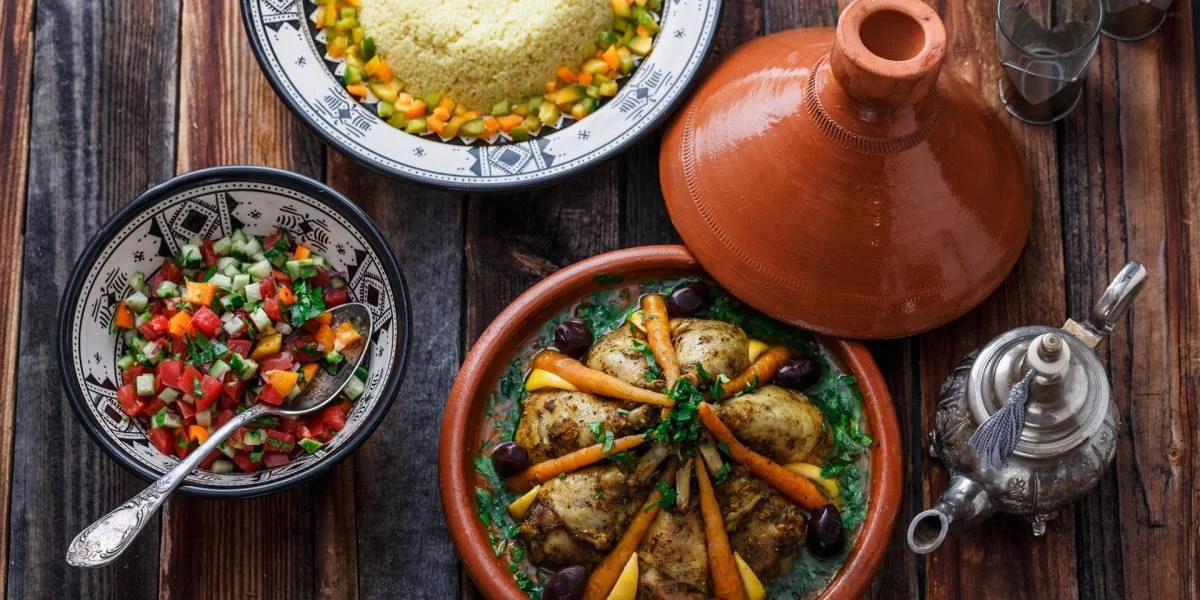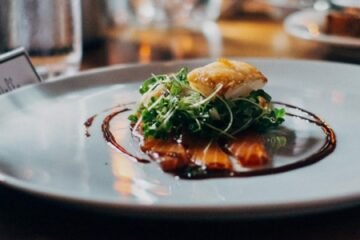Moroccan cuisine is a rich tapestry woven with vibrant colors, aromatic spices, and a blend of cultural influences. From the bustling souks of Marrakech to the serene coastal towns of Essaouira, Moroccan food tells a story of history, tradition, and passion. In this blog post, we’ll uncover the secrets of authentic traditional Moroccan cooking, revealing the techniques, ingredients, and customs that make it truly unique.
The Essence of Moroccan Cuisine

Moroccan cuisine is a delightful fusion of Berber, Arab, Andalusian, and Mediterranean influences. Its foundation lies in the use of fresh, local ingredients and a harmonious blend of spices that create complex and layered flavors. Here are the key elements that define authentic Moroccan cooking:
1. The Spice Blend: Ras el Hanout
Ras el Hanout, which translates to “head of the shop,” is a quintessential Moroccan spice blend. It typically contains a mix of 20-40 spices, including cumin, coriander, ginger, cardamom, cinnamon, nutmeg, and cloves. Each spice merchant has a secret recipe, making every Ras el Hanout unique. This blend is used in a variety of dishes, adding depth and warmth to the cuisine.
Authentic traditional Moroccan cooking is a celebration of flavors, aromas, and cultural heritage. From the intricate spice blends to the communal dining experience, every aspect of Moroccan cuisine is designed to delight the senses and bring people together.
2. The Tagine: Slow-Cooked Perfection
 The tagine is both a traditional clay cooking vessel and the name of the dishes prepared in it. The conical shape of the tagine allows steam to circulate, creating tender and flavorful stews. Moroccan tagines often feature a combination of meat (such as lamb, chicken, or beef), vegetables, dried fruits (like apricots or prunes), and a blend of spices. Slow-cooking in a tagine ensures the ingredients meld beautifully, resulting in a rich, aromatic dish
The tagine is both a traditional clay cooking vessel and the name of the dishes prepared in it. The conical shape of the tagine allows steam to circulate, creating tender and flavorful stews. Moroccan tagines often feature a combination of meat (such as lamb, chicken, or beef), vegetables, dried fruits (like apricots or prunes), and a blend of spices. Slow-cooking in a tagine ensures the ingredients meld beautifully, resulting in a rich, aromatic dish
3. Couscous: The Staple Grain
Couscous is a staple in Moroccan cuisine, made from semolina wheat granules. Traditionally steamed over a pot of simmering stew, couscous absorbs the flavors of the dish below. It is often served with vegetables, meat, and a flavorful broth. Couscous Fridays are a beloved tradition in Moroccan households, where families gather to enjoy this comforting dish.
4. Fresh Herbs and Aromatics
Fresh herbs, such as cilantro, parsley, and mint, are integral to Moroccan cooking. These herbs add brightness and freshness to dishes. Additionally, aromatics like onions, garlic, and preserved lemons (lemons that have been fermented in salt) are used to build layers of flavor in many Moroccan recipes.
5. Sweet and Savory Balance
Moroccan cuisine masterfully balances sweet and savory flavors. Ingredients like honey, dried fruits, and nuts are often paired with meats and vegetables to create a harmonious contrast. For example, the famous dish “Chicken with Preserved Lemons and Olives” combines the tartness of preserved lemons with the saltiness of olives and the sweetness of caramelized onions.
Traditional Moroccan Dishes
Now that we’ve explored the key elements of Moroccan cuisine, let’s delve into some traditional dishes that showcase these principles:
1. Chicken with Preserved Lemons and Olives
This iconic Moroccan dish features chicken simmered with preserved lemons, green olives, garlic, and a blend of spices. The result is a fragrant, zesty dish that perfectly exemplifies the balance of flavors in Moroccan cooking.
2. Lamb Tagine with Prunes and Almonds
In this dish, tender lamb is slow-cooked with prunes, almonds, onions, and a mix of spices including cinnamon and ginger. The prunes add a natural sweetness that complements the rich flavor of the lamb, while the almonds provide a satisfying crunch.
3. Harira Soup
Harira is a traditional Moroccan soup often enjoyed during Ramadan to break the fast. It’s made with tomatoes, lentils, chickpeas, and a blend of spices like ginger, turmeric, and cinnamon. Fresh herbs and a squeeze of lemon juice brighten up this hearty and nutritious soup.
4. Zaalouk
Zaalouk is a popular Moroccan salad made from roasted eggplant, tomatoes, garlic, and spices. It’s typically served as a dip with warm bread and is a delicious example of how simple ingredients can be transformed into a flavorful dish.
5. Moroccan Mint Tea
No discussion of Moroccan cuisine would be complete without mentioning Moroccan mint tea. This refreshing beverage is made with green tea, fresh mint leaves, and plenty of sugar. It’s a symbol of Moroccan hospitality and is traditionally poured from a height to create a frothy top.
Cooking Techniques and Traditions
1. Communal Dining
Moroccan meals are often enjoyed communally, with family and friends gathered around a large shared platter. Eating with the hands, and using bread to scoop up food, is a common practice that fosters a sense of connection and togetherness.
2. Time-Honored Cooking Methods
Many traditional Moroccan recipes are passed down through generations, preserving time-honored cooking methods. Slow cooking, marinating, and the use of clay pots like the tagine and the couscousiere (a special pot for steaming couscous) are essential techniques in Moroccan cuisine.
3. Seasonal and Local Ingredients
Moroccan cooking emphasizes the use of seasonal and local ingredients. Fresh produce, herbs, and spices are sourced from local markets, ensuring the highest quality and flavor in every dish.
Conclusion
Authentic traditional Moroccan cooking is a celebration of flavors, aromas, and cultural heritage. From the intricate spice blends to the communal dining experience, every aspect of Moroccan cuisine is designed to delight the senses and bring people together. By understanding and embracing these secrets, you can bring a taste of Morocco into your kitchen and enjoy the rich, vibrant flavors of this extraordinary cuisine. Happy cooking.





